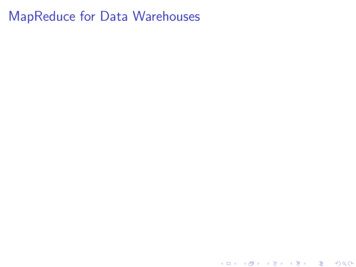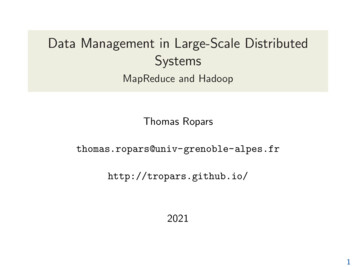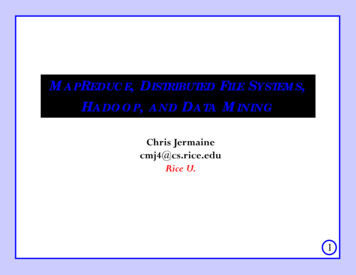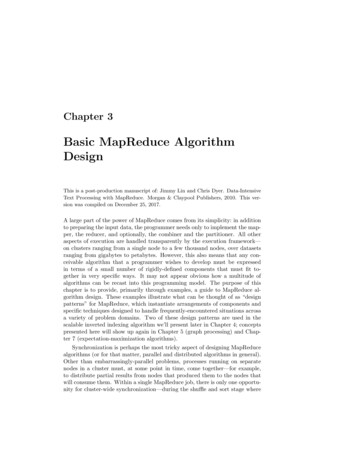
Transcription
MapReduce for Data Warehouses
Data Warehouses: Hadoop and Relational DatabasesIIn an enterprise setting, a data warehouse serves as a vast repositoryof data, holding everything from sales transactions to productinventories.
Data Warehouses: Hadoop and Relational DatabasesIIIn an enterprise setting, a data warehouse serves as a vast repositoryof data, holding everything from sales transactions to productinventories.Data warehouses form a foundation for business intelligenceapplications designed to provide decision support.
Data Warehouses: Hadoop and Relational DatabasesIIIIn an enterprise setting, a data warehouse serves as a vast repositoryof data, holding everything from sales transactions to productinventories.Data warehouses form a foundation for business intelligenceapplications designed to provide decision support.Traditionally, data warehouses have been implemented throughrelational databases, particularly those optimized for a specificworkload known as online analytical processing (OLAP).
Data Warehouses: Hadoop and Relational DatabasesIIIIIn an enterprise setting, a data warehouse serves as a vast repositoryof data, holding everything from sales transactions to productinventories.Data warehouses form a foundation for business intelligenceapplications designed to provide decision support.Traditionally, data warehouses have been implemented throughrelational databases, particularly those optimized for a specificworkload known as online analytical processing (OLAP).A number of vendors offer parallel databases, but customers find thatthey often cannot cost-effectively scale to the crushing amounts ofdata an organization needs to deal with today. Hadoop is scalableand low-cost alternative.
Data Warehouses: Hadoop and Relational DatabasesIIIIIIn an enterprise setting, a data warehouse serves as a vast repositoryof data, holding everything from sales transactions to productinventories.Data warehouses form a foundation for business intelligenceapplications designed to provide decision support.Traditionally, data warehouses have been implemented throughrelational databases, particularly those optimized for a specificworkload known as online analytical processing (OLAP).A number of vendors offer parallel databases, but customers find thatthey often cannot cost-effectively scale to the crushing amounts ofdata an organization needs to deal with today. Hadoop is scalableand low-cost alternative.Facebook developed Hive (an open source project), which allows thedata warehouse stored in Hadoop to be accessed via SQL queries(that get transformed into MapReduce operations under the hood).
Data Warehouses: Hadoop and Relational DatabasesIIIIIIIn an enterprise setting, a data warehouse serves as a vast repositoryof data, holding everything from sales transactions to productinventories.Data warehouses form a foundation for business intelligenceapplications designed to provide decision support.Traditionally, data warehouses have been implemented throughrelational databases, particularly those optimized for a specificworkload known as online analytical processing (OLAP).A number of vendors offer parallel databases, but customers find thatthey often cannot cost-effectively scale to the crushing amounts ofdata an organization needs to deal with today. Hadoop is scalableand low-cost alternative.Facebook developed Hive (an open source project), which allows thedata warehouse stored in Hadoop to be accessed via SQL queries(that get transformed into MapReduce operations under the hood).However, in many cases Hadoop and RDBMS co-exist, feeding intoone another.
Relational MapReduce PatternsBasic relational algebra operations that form the basis forrelational IDifferenceIGroupBy and AggregationIJoinHere we will implement them using MapReduce. We will also showthe corresponding SQL database queries.
Selectionselect *from Table Twhere (predicate is true);
Selectionselect *from Table Twhere (predicate is true);class Mappermethod Map(rowkey key, tuple t)if t satisfies the predicateEmit(tuple t, null)
ProjectionProjection takes a relation and a (possibly empty) list of attributes of thatrelation as input. It outputs a relation containing only the specified list ofattributes with duplicate tuples removed.selectfromA1, A2, A3 // where {A1, A2, A3} is a subsetTable T; // of the attributes for the table
ProjectionProjection takes a relation and a (possibly empty) list of attributes of thatrelation as input. It outputs a relation containing only the specified list ofattributes with duplicate tuples removed.selectfromA1, A2, A3 // where {A1, A2, A3} is a subsetTable T; // of the attributes for the tableProjection is just a little bit more complex than selection, since we use aReducer to eliminate possible duplicates.class Mappermethod Map(rowkey key, tuple t)tuple g project(t) // extract required fields to tuple gEmit(tuple g, null)class Reducermethod Reduce(tuple t, array n)Emit(tuple t, null)// n is an array of nulls
Unionselect * from Table T1Unionselect * from Table T2
Unionselect * from Table T1Unionselect * from Table T2Mappers are fed by all records of the two sets to be united.Reducer is used to eliminate duplicates.class Mappermethod Map(rowkey key, tuple t)Emit(tuple t, null)class Reducermethod Reduce(tuple t, array n) // n is an array ofEmit(tuple t, null)// one or two nulls
Intersectionselect * from Table T1Intersectionselect * from Table T2
Intersectionselect * from Table T1Intersectionselect * from Table T2Mappers are fed by all records of the two sets to be intersected.Reducer emits only records that occurred twice. It is possible onlyif both sets contain this record because the record includes primarykey and can occur in one set only once.class Mappermethod Map(rowkey key, tuple t)Emit(tuple t, null)class Reducermethod Reduce(tuple t, array n) // n is an array ofif n.size() 2// one or two nullsEmit(tuple t, null)
Differenceselect * from Table T1Exceptselect * from Table T2
Differenceselect * from Table T1Exceptselect * from Table T2Suppose we have two sets of records — R and S. We want to computedifference R - S. Mapper emits all tuples with a tag, which is a name ofthe set this record came from. Reducer emits only records that came fromR but not from S.class Mappermethod Map(rowkey key, tuple t)//t.SetName is either ’R’ or ’S’Emit(tuple t, string t.SetName)//array n can be [’R’], [’S’], [’R’ ’S’], or [’S’, ’R’]class Reducermethod Reduce(tuple t, array n)if n.size() 1 and n[1] ’R’Emit(tuple t, null)
Group By and Aggregationselect pub id, type, avg(price), sum(total sales)from titlesgroup by pub id, type
Group By and Aggregationselect pub id, type, avg(price), sum(total sales)from titlesgroup by pub id, typeIIIMapper extracts from each tuple values to group by fields andaggregate fields and emits them.Reducer receives values to be aggregated already grouped andcalculates an aggregation function. Typical aggregation functions likesum or max can be calculated in a streaming fashion, hence don’trequire handling all values simultaneously.In some cases two phase MapReduce job may be required – seepattern Distinct Values as an example.
Group By and Aggregationselect pub id, type, avg(price), sum(total sales)from titlesgroup by pub id, typeIIIMapper extracts from each tuple values to group by fields andaggregate fields and emits them.Reducer receives values to be aggregated already grouped andcalculates an aggregation function. Typical aggregation functions likesum or max can be calculated in a streaming fashion, hence don’trequire handling all values simultaneously.In some cases two phase MapReduce job may be required – seepattern Distinct Values as an example.class Mappermethod Map(null, tuple[value GroupBy, value AggregateBy, value .])Emit(value GroupBy, value AggregateBy)class Reducermethod Reduce(value GroupBy, [v1, v2,.])Emit(value GroupBy, aggregate([v1, v2,.])) //aggregate(): sum, max,
JoinIA Join is a means for combining fields from two tables by using valuescommon to each. ANSI standard SQL specifies four types of JOIN:INNER, OUTER, LEFT, and RIGHT. As a special case, a table canJOIN to itself in a self-join.
JoinIIA Join is a means for combining fields from two tables by using valuescommon to each. ANSI standard SQL specifies four types of JOIN:INNER, OUTER, LEFT, and RIGHT. As a special case, a table canJOIN to itself in a self-join.An example:CREATE TABLE department (DepartmentID INT,DepartmentName VARCHAR(20));CREATE TABLE employee (LastName VARCHAR(20),DepartmentID INT);SELECT *FROM employeeINNER JOIN department ONemployee.DepartmentID department.DepartmentID;--implicit joinSELECT *FROM employee, departmentWHERE employee.DepartmentID department.DepartmentID;
More on JoinsIRelational databases are often normalized to eliminateduplication of information when objects may haveone-to-many relationships.IJoining two tables effectively creates another table whichcombines information from both tables. This is at someexpense in terms of the time it takes to compute the join.IWhile it is also possible to simply maintain a denormalizedtable if speed is important, duplicate information may takeextra space, and add the expense and complexity ofmaintaining data integrity if data which is duplicated laterchanges.IThree fundamental algorithms for performing a join operationare: nested loop join, sort-merge join and hash join.
Join ExamplesIUser Demographics.IIILet R represent a collection of user profiles, in which case k could beinterpreted as the primary key (i.e., user id). The tuples might containdemographic information such as age, gender, income, etc.The other dataset, L, might represent logs of online activity. Each tuplemight correspond to a page view of a particular URL and may containadditional information such as time spent on the page, ad revenuegenerated, etc. The k in these tuples could be interpreted as the foreign keythat associates each individual page view with a user.Joining these two datasets would allow an analyst, for example, to breakdown online activity in terms of demographics.
Join ExamplesIUser Demographics.IIIILet R represent a collection of user profiles, in which case k could beinterpreted as the primary key (i.e., user id). The tuples might containdemographic information such as age, gender, income, etc.The other dataset, L, might represent logs of online activity. Each tuplemight correspond to a page view of a particular URL and may containadditional information such as time spent on the page, ad revenuegenerated, etc. The k in these tuples could be interpreted as the foreign keythat associates each individual page view with a user.Joining these two datasets would allow an analyst, for example, to breakdown online activity in terms of demographics.Movie Data Mining. Suppose we have three tables show below and wewant to find the top ten movies:Ratings Gender::Age::Occupation::Zip-code]Movies [MovieID::Title::Genres]
Repartition JoinJoin of two sets R and L on some key k.IIIMapper goes through all tuples from R and L, extracts key k from thetuples, marks tuple with a tag that indicates a set this tuple came from (Ror L), and emits tagged tuple using k as a key.Reducer receives all tuples for a particular key k and puts them into twobuckets for R and for L. When the two buckets are filled, Reducer runsnested loop over them and emits a cross join of the buckets.Each emitted tuple is a concatenation R-tuple, L-tuple, and key k.
Repartition JoinJoin of two sets R and L on some key k.IIIMapper goes through all tuples from R and L, extracts key k from thetuples, marks tuple with a tag that indicates a set this tuple came from (Ror L), and emits tagged tuple using k as a key.Reducer receives all tuples for a particular key k and puts them into twobuckets for R and for L. When the two buckets are filled, Reducer runsnested loop over them and emits a cross join of the buckets.Each emitted tuple is a concatenation R-tuple, L-tuple, and key k.class Mappermethod Map(null, tuple [join key k, value v1, value v2,.])Emit(join key k, tagged tuple [set name tag, values [v1, v2, .] ] )class Reducermethod Reduce(join key k, tagged tuples [t1, t2,.])H new AssociativeArray : set name - values//separate values into 2 arraysfor all tagged tuple t in [t1, t2,.]H{t.tag}.add(t.values)//produce a cross-join of the two arraysfor all values r in H{’R’}for all values l in H{’L’}Emit(null, [k r l] )
Replicated JoinIIILets assume that one of the two sets, say R, is relatively small. Thisis fairly typical in practice.If so, R can be distributed to all Mappers and each Mapper can loadit and index by the join key (e.g. in a hash table). After this, Mappergoes through tuples of the set L and joins them with thecorresponding tuples from R that are stored in the hash table.This approach is very effective because there is no need in sorting ortransmission of the set L over the network. Also known asmemory-backed join or simple hash join.
Replicated JoinIIILets assume that one of the two sets, say R, is relatively small. Thisis fairly typical in practice.If so, R can be distributed to all Mappers and each Mapper can loadit and index by the join key (e.g. in a hash table). After this, Mappergoes through tuples of the set L and joins them with thecorresponding tuples from R that are stored in the hash table.This approach is very effective because there is no need in sorting ortransmission of the set L over the network. Also known asmemory-backed join or simple hash join.class Mappermethod InitializeH new AssociativeArray : join key - tuple from RR loadR()for all [ join key k, tuple [r1, r2,.] ] in RH{k} H{k}.append( [r1, r2,.] )method Map(join key k, tuple l)for all tuple r in H{k}Emit(null, tuple [k r l] )
Join Without Scalability IssuesSuppose we have two relations, generically named S and T .(k1 , s1 , S1 )(k2 , s2 , S2 )(k3 , s3 , S3 ).where k is the key we would like to join on, sn is a unique id for the tuple,and the Sn after sn denotes other attributes in the tuple (unimportant forthe purposes of the join).(k1 , t1 , T1 )(k3 , t2 , T2 )(k8 , t3 , T3 ).where k is the join key, tn is a unique id for the tuple, and the Tn after tndenotes other attributes in the tuple.
Reduce-Side JoinIIIWe map over both datasets and emit the join key as the intermediatekey, and the tuple itself as the intermediate value. Since MapReduceguarantees that all values with the same key are brought together, alltuples will be grouped by the join key—which is exactly what we needto perform the join operation.This approach is known as a parallel sort-merge join in the databasecommunity.There are three cases to consider:IIIOne to one.One to many.Many to many.
Reduce-side Join: one to oneIThe reducer will be presented keys and lists of values alongthe lines of the following:k23 [(s64 , S64 ), (t84 , T84 )]k37 [(s68 , S68 )]k59 [(t97 , T97 ), (s81 , S81 )]k61 [(t99 , T99 )].
Reduce-side Join: one to oneIThe reducer will be presented keys and lists of values alongthe lines of the following:k23 [(s64 , S64 ), (t84 , T84 )]k37 [(s68 , S68 )]k59 [(t97 , T97 ), (s81 , S81 )]k61 [(t99 , T99 )].IIf there are two values associated with a key, then we knowthat one must be from S and the other must be from T . Wecan proceed to join the two tuples and perform additionalcomputations (e.g., filter by some other attribute, computeaggregates, etc.).IIf there is only one value associated with a key, this meansthat no tuple in the other dataset shares the join key, so thereducer does nothing.
Reduce-side Join: one to manyIIn the mapper, we instead create a composite key consisting of the joinkey and the tuple id (from either S or T ). Two additional changes arerequired:
Reduce-side Join: one to manyIIn the mapper, we instead create a composite key consisting of the joinkey and the tuple id (from either S or T ). Two additional changes arerequired:First, we must define the sort order of the keys to first sort by the join key,and then sort all tuple ids from S before all tuple ids from T .
Reduce-side Join: one to manyIIn the mapper, we instead create a composite key consisting of the joinkey and the tuple id (from either S or T ). Two additional changes arerequired:First, we must define the sort order of the keys to first sort by the join key,and then sort all tuple ids from S before all tuple ids from T .Second, we must define the partitioner to pay attention to only the joinkey, so that all composite keys with the same join key arrive at the samereducer.
Reduce-side Join: one to manyIIIIn the mapper, we instead create a composite key consisting of the joinkey and the tuple id (from either S or T ). Two additional changes arerequired:First, we must define the sort order of the keys to first sort by the join key,and then sort all tuple ids from S before all tuple ids from T .Second, we must define the partitioner to pay attention to only the joinkey, so that all composite keys with the same join key arrive at the samereducer.After applying the value-to-key conversion design pattern, the reducer willbe presented with keys and values along the lines of the following:(k82 , s105 ) [(S105 )](k82 , t98 ) [(T98 )](k82 , t101 ) [(T101 )](k82 , t137 ) [(T137 )].Whenever the reducer encounters a new join key, it is guaranteed that theassociated value will be the relevant tuple from S. The reducer can holdthis tuple in memory and then proceed to cross it with tuples from T insubsequent steps (until a new join key is encountered).
Reduce-side Join: one to manyIIIIIn the mapper, we instead create a composite key consisting of the joinkey and the tuple id (from either S or T ). Two additional changes arerequired:First, we must define the sort order of the keys to first sort by the join key,and then sort all tuple ids from S before all tuple ids from T .Second, we must define the partitioner to pay attention to only the joinkey, so that all composite keys with the same join key arrive at the samereducer.After applying the value-to-key conversion design pattern, the reducer willbe presented with keys and values along the lines of the following:(k82 , s105 ) [(S105 )](k82 , t98 ) [(T98 )](k82 , t101 ) [(T101 )](k82 , t137 ) [(T137 )].Whenever the reducer encounters a new join key, it is guaranteed that theassociated value will be the relevant tuple from S. The reducer can holdthis tuple in memory and then proceed to cross it with tuples from T insubsequent steps (until a new join key is encountered).Since the MapReduce execution framework performs the sorting, there isno need to buffer tuples (other than the single one from S). Thus, wehave eliminated the scalability bottleneck.
Reduce-side Join: many to manyIAll the tuples from S with the same join key will beencountered first, which the reducer can buffer in memory. Asthe reducer processes each tuple from T , it is crossed with allthe tuples from S. Of course, we are assuming that the tuplesfrom S (with the same join key) will fit into memory, which isa limitation of this algorithm (and why we want to control thesort order so that the smaller dataset comes first).
HiveIHive was created at Facebook to make it possible for analystswith strong SQL skills (but meager Java programming skills)to run queries on the huge volumes of data that Facebookstored in HDFS.IToday, Hive is a successful open source Apache project usedby many organizations as a general-purpose, scalable dataprocessing platform.IHive Query Language is very similar to SQL. The datascientist can write Hive queries in the hive shell (or Hive webinterface or via an API to a Hive server). The queries getconverted into MapReduce operations and run on HadoopHDFS file system.
Hadoop and Hive: A Local Case StudyISimulated a business intelligence problem that was given to us by a localsoftware company. Currently they solve the problem using a traditionaldatabase. If we were to store the data in HDFS, we could exploit theparallel processing capability of MapReduce/Hive.
Hadoop and Hive: A Local Case StudyISimulated a business intelligence problem that was given to us by a localsoftware company. Currently they solve the problem using a traditionaldatabase. If we were to store the data in HDFS, we could exploit theparallel processing capability of MapReduce/Hive.ISetup. A 5000 database server with 8 cores and 8G of memory versusfour commodity dual-core nodes with 2G of memory and worth about 1200 each for the HDFS cluster.
Hadoop and Hive: A Local Case StudyISimulated a business intelligence problem that was given to us by a localsoftware company. Currently they solve the problem using a traditionaldatabase. If we were to store the data in HDFS, we could exploit theparallel processing capability of MapReduce/Hive.ISetup. A 5000 database server with 8 cores and 8G of memory versusfour commodity dual-core nodes with 2G of memory and worth about 1200 each for the HDFS cluster.IResults. Increase data size until Hadoop/Hive outperforms the databasesolution.
Hadoop and Hive: A Local Case StudyISimulated a business intelligence problem that was given to us by a localsoftware company. Currently they solve the problem using a traditionaldatabase. If we were to store the data in HDFS, we could exploit theparallel processing capability of MapReduce/Hive.ISetup. A 5000 database server with 8 cores and 8G of memory versusfour commodity dual-core nodes with 2G of memory and worth about 1200 each for the HDFS cluster.IResults. Increase data size until Hadoop/Hive outperforms the databasesolution.Data size Hadoop Speedup Hive Speedup3G0.60.14G2.60.410G17.52.520G23.93.8
Hadoop and Hive: A Local Case StudyISimulated a business intelligence problem that was given to us by a localsoftware company. Currently they solve the problem using a traditionaldatabase. If we were to store the data in HDFS, we could exploit theparallel processing capability of MapReduce/Hive.ISetup. A 5000 database server with 8 cores and 8G of memory versusfour commodity dual-core nodes with 2G of memory and worth about 1200 each for the HDFS cluster.IResults. Increase data size until Hadoop/Hive outperforms the databasesolution.Data size Hadoop Speedup Hive Speedup3G0.60.14G2.60.410G17.52.520G23.93.8The Hive-based solution required no programming! The MapReducesolution did require programming but was simpler than traditional parallelprogramming.I
HBaseIHBase is a distributed column-oriented database built on topof HDFS. HBase is the Hadoop application to use when yourequire real-time read/write random access to very largedatasets.IHBase is not relational and does not support SQL but it cansupport very large, sparsely populated tables on clusters madefrom commodity hardware.IIntegrated with Hadoop MapReduce for powerful access.
RDBMS StoryIInitial public launch.
RDBMS StoryIInitial public launch.Move from local workstation to shared, remotely hosted MySQL instancewith a well-defined schema.
RDBMS StoryIIInitial public launch.Move from local workstation to shared, remotely hosted MySQL instancewith a well-defined schema.Service becomes more popular; too many reads hitting the database.
RDBMS StoryIIInitial public launch.Move from local workstation to shared, remotely hosted MySQL instancewith a well-defined schema.Service becomes more popular; too many reads hitting the database.Add memcached to cache common queries. Reads are now no longerstrictly ACID (Atomicity, Consistency, Isolation, Durability); cached datamust expire.
RDBMS StoryIIIInitial public launch.Move from local workstation to shared, remotely hosted MySQL instancewith a well-defined schema.Service becomes more popular; too many reads hitting the database.Add memcached to cache common queries. Reads are now no longerstrictly ACID (Atomicity, Consistency, Isolation, Durability); cached datamust expire.Service continues to grow in popularity; too many writes hitting thedatabase.
RDBMS StoryIIIInitial public launch.Move from local workstation to shared, remotely hosted MySQL instancewith a well-defined schema.Service becomes more popular; too many reads hitting the database.Add memcached to cache common queries. Reads are now no longerstrictly ACID (Atomicity, Consistency, Isolation, Durability); cached datamust expire.Service continues to grow in popularity; too many writes hitting thedatabase.Scale MySQL vertically by buying a beefed-up server with 16 cores, 128GB of RAM, and banks of 15k RPM hard drives. Costly.
RDBMS StoryIIIIInitial public launch.Move from local workstation to shared, remotely hosted MySQL instancewith a well-defined schema.Service becomes more popular; too many reads hitting the database.Add memcached to cache common queries. Reads are now no longerstrictly ACID (Atomicity, Consistency, Isolation, Durability); cached datamust expire.Service continues to grow in popularity; too many writes hitting thedatabase.Scale MySQL vertically by buying a beefed-up server with 16 cores, 128GB of RAM, and banks of 15k RPM hard drives. Costly.New features increases query complexity; now we have too many joins.
RDBMS StoryIIIIInitial public launch.Move from local workstation to shared, remotely hosted MySQL instancewith a well-defined schema.Service becomes more popular; too many reads hitting the database.Add memcached to cache common queries. Reads are now no longerstrictly ACID (Atomicity, Consistency, Isolation, Durability); cached datamust expire.Service continues to grow in popularity; too many writes hitting thedatabase.Scale MySQL vertically by buying a beefed-up server with 16 cores, 128GB of RAM, and banks of 15k RPM hard drives. Costly.New features increases query complexity; now we have too many joins.Denormalize your data to reduce joins. (That’s not what they taught mein DBA school!)
RDBMS StoryIIIIIInitial public launch.Move from local workstation to shared, remotely hosted MySQL instancewith a well-defined schema.Service becomes more popular; too many reads hitting the database.Add memcached to cache common queries. Reads are now no longerstrictly ACID (Atomicity, Consistency, Isolation, Durability); cached datamust expire.Service continues to grow in popularity; too many writes hitting thedatabase.Scale MySQL vertically by buying a beefed-up server with 16 cores, 128GB of RAM, and banks of 15k RPM hard drives. Costly.New features increases query complexity; now we have too many joins.Denormalize your data to reduce joins. (That’s not what they taught mein DBA school!)Rising popularity swamps the server; things are too slow.
RDBMS StoryIIIIIInitial public launch.Move from local workstation to shared, remotely hosted MySQL instancewith a well-defined schema.Service becomes more popular; too many reads hitting the database.Add memcached to cache common queries. Reads are now no longerstrictly ACID (Atomicity, Consistency, Isolation, Durability); cached datamust expire.Service continues to grow in popularity; too many writes hitting thedatabase.Scale MySQL vertically by buying a beefed-up server with 16 cores, 128GB of RAM, and banks of 15k RPM hard drives. Costly.New features increases query complexity; now we have too many joins.Denormalize your data to reduce joins. (That’s not what they taught mein DBA school!)Rising popularity swamps the server; things are too slow.Stop doing any server-side computations.
RDBMS StoryIIIIIIInitial public launch.Move from local workstation to shared, remotely hosted MySQL instancewith a well-defined schema.Service becomes more popular; too many reads hitting the database.Add memcached to cache common queries. Reads are now no longerstrictly ACID (Atomicity, Consistency, Isolation, Durability); cached datamust expire.Service continues to grow in popularity; too many writes hitting thedatabase.Scale MySQL vertically by buying a beefed-up server with 16 cores, 128GB of RAM, and banks of 15k RPM hard drives. Costly.New features increases query complexity; now we have too many joins.Denormalize your data to reduce joins. (That’s not what they taught mein DBA school!)Rising popularity swamps the server; things are too slow.Stop doing any server-side computations.Some queries are still too slow.
RDBMS StoryIIIIIIInitial public launch.Move from local workstation to shared, remotely hosted MySQL instancewith a well-defined schema.Service becomes more popular; too many reads hitting the database.Add memcached to cache common queries. Reads are now no longerstrictly ACID (Atomicity, Consistency, Isolation, Durability); cached datamust expire.Service continues to grow in popularity; too many writes hitting thedatabase.Scale MySQL vertically by buying a beefed-up server with 16 cores, 128GB of RAM, and banks of 15k RPM hard drives. Costly.New features increases query complexity; now we have too many joins.Denormalize your data to reduce joins. (That’s not what they taught mein DBA school!)Rising popularity swamps the server; things are too slow.Stop doing any server-side computations.Some queries are still too slow.Periodically prematerialize the most complex queries, and try to stopjoining in most cases.
RDBMS StoryIIIIIIIInitial public launch.Move from local workstation to shared, remotely hosted MySQL instancewith a well-defined schema.Service becomes more popular; too many reads hitting the database.Add memcached to cache common queries. Reads are now no longerstrictly ACID (Atomicity, Consistency, Isolation, Durability); cached datamust expire.Service continues to grow in popularity; too many writes hitting thedatabase.Scale MySQL vertically by buying a beefed-up server with 16
data warehouse stored in Hadoop to be accessed via SQL queries (that get transformed into MapReduce operations under the hood). I However, in many cases Hadoop and RDBMS co-exist, feeding into one another. Relational MapReduce Patterns Basic relational algebra operations that form the basis for










